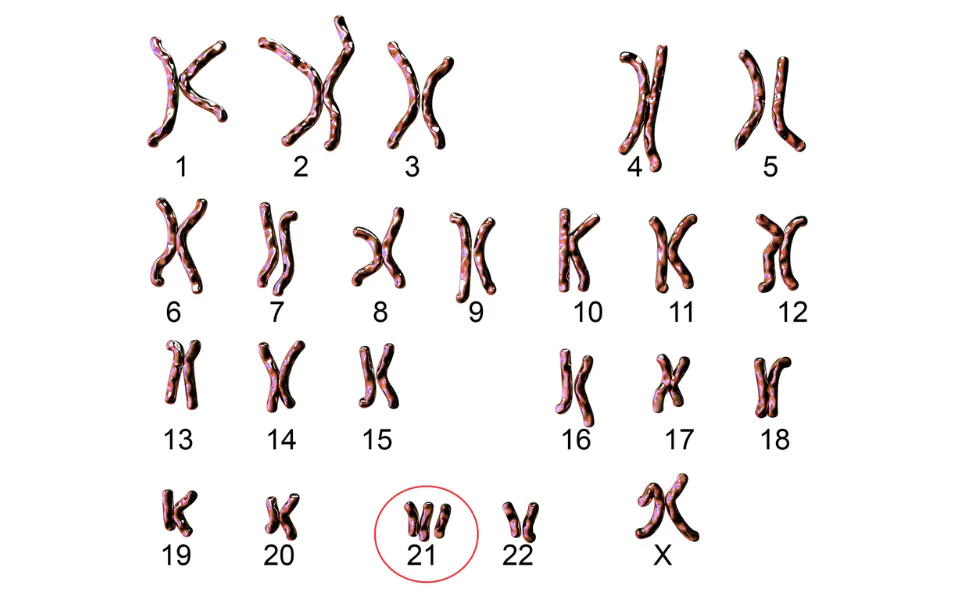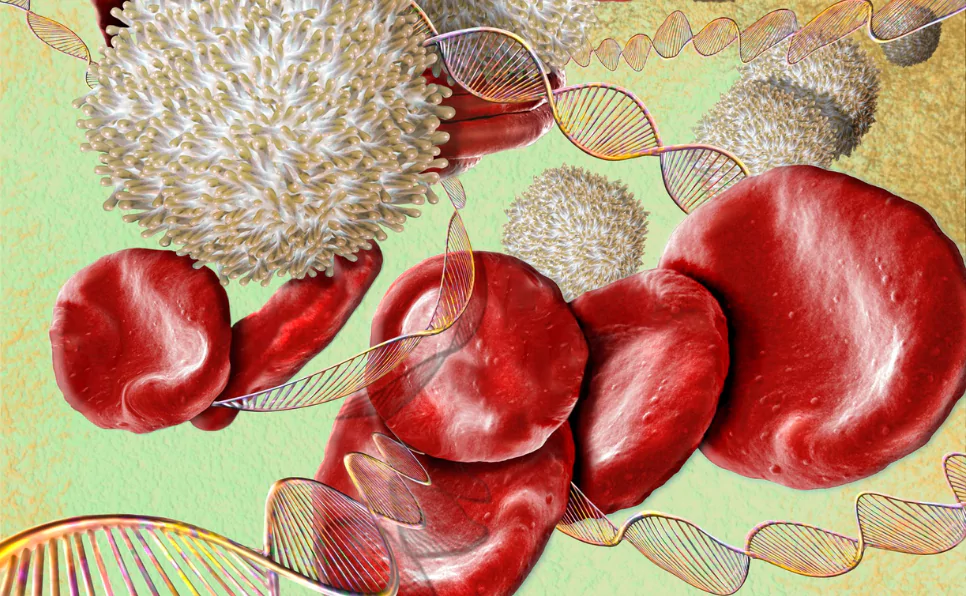Genetic diseases, or genetic disorders, are health troubles that happen because of changes in a person’s DNA. DNA is like the instruction manual for our body, telling our cells what to do and how we get our physical traits from our parents.
Sometimes, there can be mistakes, or genetic mutations in humans, in these instructions that disrupt our bodies’ normal growth or operation. Genetic diseases can affect any part of our body and lead to various symptoms and complications. Some of these diseases are there when a person is born, while others may come up later in life.
Understanding these genetic conditions is vital for many reasons. First, it allows us to pinpoint these diseases’ causes and risk elements and find methods to prevent or cure them. Second, it enables us to provide correct diagnosis and advice for people who have or might have a genetic disease or who might pass it to their children.
In this article, we’ll delve into the following aspects of genetic diseases:
- What are genes and genetic diseases?
- What are the different types of genetic disorders?
- How are genetic diseases passed on in families?
- What are some examples of genetic diseases in each type?
What are genes and genetic diseases?
Genes are parts of DNA that make specific proteins. Proteins are molecules that do various things in the body, like building structures, controlling processes, moving substances, fighting infections, and sending signals.
Each gene has a specific spot on a chromosome, which is a long strand of DNA that holds many genes. Humans have 23 pairs of chromosomes, one pair inherited from each parent.
Genetic diseases happen when there’s a mutation or an abnormality in one or more genes or chromosomes.
- A mutation is a change in the sequence of DNA bases (A, T, C, G) that make up a gene. A mutation can change the protein that the gene makes or stop it from being produced at all. A mutation can be passed on from one or both parents or happen randomly during cell division or due to things in the environment like radiation, chemicals, viruses, etc.
- A chromosomal abnormality is a change in the number or structure of chromosomes. It can result in missing or extra genetic material or shuffling of genes on different chromosomes. This abnormality can occur during the creation of egg or sperm cells (meiosis) or during early development of an embryo.

Different types of genetic disorders?
Genetic diseases can be split into three main categories based on the type and number of genes involved:
- Single-gene disorders: These diseases happen due to mutations in one gene. They’re also known as monogenic disorders or Mendelian disorders because they follow simple inheritance patterns based on Mendel’s laws of genetics. There are four kinds of single-gene disorders: autosomal dominant, autosomal recessive, X-linked dominant, and X-linked recessive.
- Chromosomal disorders: These diseases occur due to abnormalities in the number or structure of chromosomes. They’re also called aneuploidies (when there’s an extra or missing chromosome) or structural aberrations (when there’s a deletion, duplication, inversion, translocation, or ring formation of a chromosome segment). Chromosomal disorders usually affect multiple genes and can cause severe developmental problems.
- Complex disorders: These diseases occur due to a combination of mutations in several genes and environmental factors. They’re also known as multifactorial disorders or polygenic disorders because many factors influence the expression and severity of the disease. Complex disorders don’t follow simple inheritance patterns and often have variable symptoms and outcomes.
We will discuss all of them in detail later.
How are genetic diseases inherited?
The way a genetic disease is passed on depends on several factors, like:
- The type and location of the gene or chromosome involved.
- The mode of transmission (dominant or recessive) of the gene mutation.
- The gender of the individual and the parent who carries the mutation.
- The presence of other genes or environmental factors that modify the disease.
The following table breaks down some common inheritance patterns of genetic diseases:
| Inheritance Pattern | Description | Example |
|---|---|---|
| Autosomal dominant | A mutation in one copy of a gene on a non-sex chromosome (autosome) causes the disease. An affected person has a 50% chance of passing on the mutation to each child. | Huntington’s disease |
| Autosomal recessive | A mutation in both copies of a gene on an autosome causes the disease. An affected person inherits one mutated copy from each parent. A carrier is a person who has one mutated copy and one normal copy of the gene. A carrier does not have the disease but can pass on the mutation to the offspring. Two carriers have a 25% chance of having an affected child, a 50% chance of having a carrier child, and a 25% chance of having a normal child. | Cystic fibrosis |
| X-linked dominant | A mutation in one copy of a gene on the X chromosome (sex chromosome) causes the disease. A female has two X chromosomes, while a male has one X and one Y chromosome. An affected female has a 50% chance of passing on the mutation to each child, regardless of their sex. An affected male passes on the mutation to all his daughters but none of his sons. | Rett syndrome |
| X-linked recessive | A mutation in both copies of a gene on the X chromosome causes the disease in females, while a mutation in one copy causes the disease in males. A female can be affected, carrier, or normal depending on the number and type of X chromosomes she inherits from her parents. A male can only be affected or normal depending on the type of X chromosome he inherits from his mother. An affected male passes on the mutation to all his daughters (who become carriers) but none of his sons. A carrier female has a 50% chance of passing on the mutation to each child. If she passes it to a son, he will be affected; if she passes it to a daughter, she will be a carrier. | Hemophilia |
| Mitochondrial | A mutation in the DNA of mitochondria (small parts of the cell that produce energy) causes the disease. Mitochondria are only inherited from the mother, as they’re present in the egg cell but not in the sperm cell. An affected mother passes on the mutation to all her children, regardless of their sex. An affected father does not pass on the mutation to any of his children. | Leber’s hereditary optic neuropathy |
A few examples of genetic diseases
The following table lists some examples of genetic diseases in each type along with their symptoms and causes:
| Type | Disease | Symptoms | Causes |
|---|---|---|---|
| Single-gene disorders | Huntington’s disease | Progressive loss of movement, thinking, and behavior control; dementia; death usually within 15-20 years after onset | Mutation in the HTT gene on chromosome 4; autosomal dominant inheritance |
| Single-gene disorders | Cystic fibrosis | Thick mucus buildup in the lungs, pancreas, and other organs; chronic lung infections; digestive problems; infertility; reduced life expectancy | Mutation in the CFTR gene on chromosome 7; autosomal recessive inheritance |
| Single-gene disorders | Rett syndrome | Severe impairment of brain development; loss of speech and motor skills; seizures; breathing problems; scoliosis; growth failure; usually affects females only | Mutation in the MECP2 gene on the X chromosome; X-linked dominant inheritance |
| Single-gene disorders | Hemophilia | Excessive bleeding and bruising; joint pain and swelling; anemia; risk of internal bleeding and organ damage; usually affects males only | Mutation in the F8 or F9 gene on the X chromosome; X-linked recessive inheritance |
| Chromosomal disorders | Down syndrome | Intellectual disability; distinctive facial features; heart defects; increased risk of leukemia and Alzheimer’s disease | Extra copy of chromosome 21 (trisomy 21); usually occurs due to errors during cell division |
| Chromosomal disorders | Fragile X syndrome | Intellectual disability; learning difficulties; behavioral problems; large ears and forehead; long face; hyperflexible joints; usually more severe in males than females | Expansion of CGG repeats in the FMR1 gene on the X chromosome; X-linked dominant inheritance with reduced penetrance |
| Chromosomal disorders | Klinefelter syndrome | Male infertility; small testes; low testosterone levels; enlarged breasts; tall stature; learning difficulties; usually affects males only | Extra X chromosome (XXY); usually occurs due to errors during cell division |
| Chromosomal disorders | Turner syndrome | Female infertility; short stature; webbed neck; low hairline; heart defects; kidney problems; usually affects females only | Missing or partially missing X chromosome (X0); usually occurs due to errors during cell division |
| Complex disorders | Alzheimer’s disease | Progressive loss of memory, thinking, and behavior control; dementia; death usually within 10 years after onset | Combination of genetic and environmental factors; mutations in genes such as APP, PSEN1, PSEN2, APOE increase risk |
| Complex disorders | Diabetes mellitus type 2 | High blood sugar levels due to insulin resistance or deficiency; increased thirst and urination; fatigue; blurred vision; increased risk of heart disease, kidney disease, nerve damage, eye damage, etc. | Combination of genetic and environmental factors like obesity, diet, physical activity, age, etc.; mutations in genes such as TCF7L2, KCNJ11, PPARG increase risk |
How genetic mutations cause diseases
Mutations in our genes can cause diseases in several ways. Sometimes, a mutation stops a protein from being made, or it creates a faulty protein that can’t do its job properly.
An example of this is sickle cell disease. This is a genetic condition caused by a mutation in the gene responsible for making hemoglobin, a protein that carries oxygen in our red blood cells. The mutation changes the shape of the hemoglobin and the red blood cells become sickle-shaped. This can block blood vessels and lead to pain, anemia, and damage to organs.
In other cases, mutations can mess up the way our body controls a gene’s activity, like when it should be turned on or off.
Certain types of cancers, which are also genetic disorders, are caused by mutations that switch on genes that help cells grow (oncogenes) or turn off genes that stop cells from growing too much (tumor suppressor genes). This leads to cells growing out of control and forming tumors.
Then there are mutations that don’t affect the protein itself, but they affect how the protein interacts with other things in our body or responds to signals.
A disease that’s caused by this kind of mutation is cystic fibrosis. It’s caused by a mutation in a gene that makes a protein which transports chloride ions across cell membranes. This mutation makes this protein less effective, which leads to a buildup of thick mucus in the lungs and other organs. This causes infections and breathing problems.
Single-gene disorders: Dominant, Recessive, X-linked
Some genetic diseases, known as single-gene disorders, are caused by a mutation in just one gene. How these diseases are inherited depends on if the gene is on a non-sex chromosome (an autosome) or a sex chromosome (X or Y), and whether the mutation is dominant or recessive.
A dominant mutation is one that causes a disease even if only one copy of the gene has a mutation. Someone with a dominant mutation can inherit it from just one parent who has the disease, or from a new mutation that happens when sex cells are being formed or early in development.
Huntington’s disease is an example of a dominant single-gene disorder. It causes progressive nerve degeneration and impacts movement, thinking, and behavior.
A recessive mutation only causes a disease if both copies of the gene have the mutation. Someone with a recessive mutation can inherit it from both parents who are carriers (meaning they have one mutated and one normal copy of the gene), or from one parent with the disease and one who is a carrier.
Tay-Sachs disease, which causes fatal brain damage in infants because they can’t break down fatty substances, is an example of a recessive single-gene disorder.
X-linked mutations are ones that happen on the X chromosome, which is one of the sex chromosomes. Males have one X and one Y chromosome, while females have two X chromosomes.
So, males are more likely to get X-linked disorders because they only have one X chromosome and can’t compensate for a mutated gene with a normal copy like females can.
Females can be affected if they inherit two mutated X chromosomes, or if they have a condition called X-inactivation, which randomly turns off one of the X chromosomes in each cell. Hemophilia, a disease that causes abnormal bleeding because of a lack of a clotting factor, is an example of an X-linked disorder.
Chromosomal disorders: Translocation, Deletion, Duplication
Chromosomal disorders are genetic diseases caused by changes in the number or structure of chromosomes, which hold our genes/DNA within each cell. These changes can happen during the formation of sex cells or early in development, and can affect all or part of a chromosome.

A translocation is when a piece of one chromosome breaks off and attaches to another chromosome.
This can result in an exchange of genetic material between different chromosomes (reciprocal translocation) or additional genetic material being added to another chromosome (non-reciprocal translocation).
Translocations can mess up the way genes work or are expressed if they are located at or near the breakpoints.
Chronic myeloid leukemia, a cancer caused by a reciprocal translocation between chromosomes 9 and 22, is an example of a disorder caused by a translocation.
Deletions are when a piece of a chromosome is missing, resulting in a loss of genetic material and the absence of genes that should be on that segment. Deletions can affect the way genes on the remaining part of the chromosome work or are expressed.
Cri du Chat syndrome, a disorder caused by a deletion of part of chromosome 5, is an example of a disorder caused by a deletion. This leads to a distinctive cry, intellectual disability, and other physical features.
Duplications occur when a piece of a chromosome is present twice, resulting in additional genetic material and extra copies of genes that should be on that segment.
Duplications can affect the way genes on the duplicated part of the chromosome work or are expressed. Charcot-Marie-Tooth disease type 1A, caused by a duplication of part of chromosome 17, is an example of a disorder caused by a duplication.
This results in too much of a protein that affects nerve function.
Multifactorial inheritance in complex disorders
Multifactorial inheritance involves multiple genes and environmental factors. Complex disorders are genetic diseases caused by this type of inheritance.
These disorders come about from the combined effects of variations in several genes, along with interactions with environmental factors, like diet, lifestyle, exposure to toxins or infections.
Complex disorders are more common than single-gene or chromosomal disorders. However, they’re also harder to study and predict because they involve many factors that can differ from person to person and change over time.
Some examples of complex disorders are diabetes, heart disease, cancer, Alzheimer’s disease, autism, and schizophrenia. These diseases often run in families, but they don’t follow a simple pattern of inheritance, like one gene or one mode of inheritance.
Instead, they’re influenced by many genes, each with a small effect on the disease risk. The risk also depends on how these genes interact with each other and with environmental factors.
The study of complex disorders needs advanced methods and technologies, like genome-wide association studies (GWAS), which look at the whole genome for variations associated with disease risk, and polygenic risk scores (PRS), which estimate the overall effect of multiple genetic variants on disease risk.
There are also gene-environment interaction studies, which look at how environmental factors modify or interact with genetic factors to influence disease risk.
These studies aim to identify the genetic and environmental factors that contribute to complex disorders and to find better ways to prevent, diagnose, and treat them.
Diagnosing Genetic Diseases
Genetic testing involves studying a person’s DNA, proteins, or metabolites to spot any genetic diseases or susceptibilities. This kind of testing gives us insights into a person’s health, such as:
- Whether they have a genetic disease or condition causing symptoms
- Whether they are likely to develop a hereditary disease in the future
- Whether they carry a disease gene that they could pass on to their kids
- Whether they possess a genetic variation that could impact their reaction to certain medicines or treatments
So, genetic testing can help identify a genetic disease, confirm if someone has a suspected disease, eliminate other possible causes of symptoms, guide medical management and treatment, and help in making decisions about family planning.
Various kinds of genetic testing
There are many types of genetic tests which can be performed for various reasons and at different life stages. Some of the common types of genetic testing include:
- Preimplantation genetic diagnosis (PGD): This is a test done on embryos made through IVF before they are implanted in the womb. PGD can spot genetic abnormalities in the embryos and help select healthy ones for implantation. PGD can prevent passing on certain hereditary diseases to the baby and reduce the risk of miscarriage or complications during pregnancy.
- Prenatal testing: This type of testing is done during pregnancy to check the health and development of the baby in the womb. Prenatal testing can include screening tests and diagnostic tests. Screening tests can estimate the likelihood of the baby having certain chromosomal abnormalities like Down syndrome, or other genetic conditions like cystic fibrosis. Diagnostic tests can confirm or eliminate specific genetic disorders in the baby by analyzing samples of fetal cells, blood, or fluid. Prenatal testing can help parents prepare for the birth of a child with special needs or make decisions about continuing or terminating the pregnancy.
- Newborn screening: This type of testing is done on newborn babies within the first few days after birth. Newborn screening can identify certain metabolic, hormonal, or blood disorders that can cause serious health problems if not treated early. Newborn screening includes blood tests, hearing tests, and pulse oximetry tests. Newborn screening can prevent disability, developmental delays, or death from treatable conditions.
Limitations and ethical considerations of genetic testing
Genetic testing is not flawless and has some limitations and challenges, such as:
- Genetic testing may not be available or accessible for all conditions or populations
- Genetic testing may not be accurate or reliable for some conditions or variants
- Genetic testing may not provide clear or conclusive results for some conditions or variants
- Genetic testing may have physical, emotional, psychological, social, or financial implications for individuals and families
- Genetic testing may raise ethical issues such as privacy, confidentiality, consent, discrimination, stigmatization, or eugenics
Genetic testing should be done with informed consent and counseling from qualified health professionals who can explain the benefits, risks, limitations, and implications of the test results.
Managing and Treating Genetic Disorders
Genetic diseases are often lifelong and incurable conditions that require constant management and care. However, advancements in science and technology have led to various strategies and treatments that can enhance the quality of life and prognosis of people with genetic disorders.
The management of genetic diseases depends on the type, severity, and symptoms of the condition. Some of the common strategies for managing genetic diseases include:
- Prevention: This involves reducing the risk or occurrence of genetic diseases by avoiding exposure to environmental triggers, changing lifestyle factors, taking preventive medications or supplements, undergoing prenatal testing or preimplantation genetic diagnosis, or considering adoption or donor gametes.
- Screening: This involves detecting genetic diseases early by performing newborn screening or carrier testing to enable timely intervention and treatment.
- Diagnosis: This involves confirming the presence and cause of a genetic disease by performing diagnostic tests such as karyotyping, microarray, or sequencing to guide medical management and treatment.
- Monitoring: This involves tracking the progression and complications of a genetic disease by performing regular tests such as blood tests, imaging tests, or biopsies to evaluate the response to treatment and adjust the dosage or regimen as needed.
- Support: This involves providing physical, emotional, psychological, social, or financial support to individuals and families affected by genetic diseases by offering counseling, education, advocacy, peer support, or financial assistance.
Treatments
No single treatment can cure all genetic diseases. Mostly genetic disorders are managed by symptom relief therapies. However, there are some treatments that can target the root cause or mechanism of a genetic disease, such as:
- Gene therapy: This is a type of treatment that introduces a normal or modified gene into the cells of a person with a genetic disease to replace or correct a faulty gene. Gene therapy can be done using viral vectors, non-viral vectors, or gene editing tools. Gene therapy can restore the function of a missing or defective protein, enzyme, or hormone, or modify the expression of a gene. Gene therapy is still experimental and has been approved for only a few conditions, such as spinal muscular atrophy, hemophilia, and retinal dystrophy.
- Enzyme replacement therapy (ERT): This is a treatment that administers a synthetic or recombinant enzyme to a person with a genetic disease that causes a deficiency or dysfunction of a natural enzyme. ERT can supplement the activity of the missing or defective enzyme and prevent the accumulation of toxic substances or the depletion of essential substances in the body. ERT is available for some conditions, such as Gaucher disease, Fabry disease, and Pompe disease.
- Dietary restrictions: This treatment involves limiting or avoiding certain foods or nutrients that can trigger or worsen the symptoms of a genetic disease. Dietary restrictions can prevent the buildup of harmful metabolites or the deficiency of vital cofactors in the body. Dietary restrictions are used for some conditions, such as phenylketonuria, galactosemia, and celiac disease.
Challenges in treating genetic diseases
The treatment of genetic diseases faces many challenges and barriers, such as:
- The complexity and diversity of genetic diseases and their molecular mechanisms
- The rarity and heterogeneity of some genetic diseases and their patient populations
- The difficulty and cost of developing and delivering effective and safe treatments
- The lack of awareness and access to existing treatments
- The ethical and regulatory issues involved in testing and approving new treatments
- The uncertainty and variability of the outcomes and side effects of treatments
Future of treatments for genetic disorders
The field of genetic disease treatment is constantly evolving and expanding with new discoveries and innovations. Some of the emerging treatments and technologies that may offer new hope and opportunities for people with genetic diseases include:
- Stem cell therapy: This treatment uses stem cells to create healthy cells or tissues that can replace damaged or diseased ones. Stem cells can be obtained from embryonic sources, adult sources, or induced pluripotent sources. Stem cell therapy can potentially treat conditions such as diabetes, Parkinson’s disease, and spinal cord injury.
- CRISPR-Cas9: This is a gene editing tool that uses a bacterial enzyme (Cas9) and a guide RNA (CRISPR) to cut and modify specific sequences of DNA in living cells. CRISPR-Cas9 can potentially correct mutations, insert genes, delete genes, or regulate gene expression. CRISPR-Cas9 can potentially treat conditions such as cystic fibrosis, sickle cell disease, and cancer.
- Nanomedicine: This treatment involves using tiny materials or devices to deliver drugs, genes, or other agents to specific targets in the body. Nanomedicine can enhance the effectiveness, specificity, safety, and bioavailability of treatments. Nanomedicine can potentially treat conditions such as Alzheimer’s disease, tuberculosis, and HIV.
The future of genetic disease treatment may depend on the collaboration of various disciplines and stakeholders, such as genomics, bioinformatics, biotechnology, pharmacology, medicine, ethics, law, policy, industry, academia, and patients.
How Genetic Diseases Affect People and Communities
Here are some ways genetic diseases can make life tough:
- Struggles caused by genetic diseases: These disorders can lead to physical issues, like pain, disability, irregular shapes, or dying young. They can also mess with the emotions of those who have the disease and their families, leading to feelings of stress, worry, sadness, blame, or loss. On top of that, having a genetic condition can make it hard for people to fit in, leading to unfair treatment, not getting the care or education they need, fewer job chances, and loneliness.
- Unfair treatment because of genetic diseases: Those with genetic disorders can be judged wrongly or unfairly by others who don’t get what they’re going through or who think badly of them. This can lead to being left out, bullying, harassment, violence, or having their rights violated. It can also harm the self-worth and mental health of those who have the disease and their families.
The importance of help groups
Support groups and advocacy organizations can be a lifesaver for people with genetic diseases. They offer a helping hand, with things like emotional support, information, education, counseling, meeting others in the same boat, financial help, or legal advice.
They can also help spread the word, push for research, affect policies, and protect the rights of those with genetic diseases.
The Future of Genetic Research
Genetic research is a quickly advancing field that is working hard to figure out what causes genetic disorders, how they work, how to spot them, stop them, and treat them. The field has made huge leaps in the last few years and is opening up new ways to make humans healthier and happier.
Here are some awesome things going on in genetic research:
- New findings in genetic research: Genetic studies have identified thousands of genes and variants linked with all kinds of diseases and traits. New tools and ways of looking at genetic data have also come about, such as reading whole genomes, editing genes, gene therapy, stem cell therapy, or personalized medicine. These tools are letting scientists delve into the vast, varied world of human genetics and find new ways to cure or change genetic diseases.
- Possible future cures and discoveries: Genetic research might completely change how we treat genetic diseases by coming up with new cures that go after what’s causing the disease, not just the symptoms. Some possible future cures include gene therapy (putting a healthy gene into a cell), gene editing (fixing a broken gene in a cell), stem cell therapy (replacing bad cells with good ones from stem cells), or personalized medicine (tweaking treatment based on a person’s genetic makeup).
- Questions about right and wrong in advanced genetic technologies: While genetic research holds a lot of hope for making humans healthier and happier, it also brings up tough questions about what’s right and wrong that we need to think through. Some examples include how safe and effective genetic interventions are, how to keep genetic information private and get consent, how to make genetic services available to everyone, how to regulate genetic research and applications, or the social impacts of knowing and changing our genetics. These issues need a lot of careful thought and conversation among researchers, policymakers, health professionals, patients, families, and the whole community.
Final Words
Genetic diseases are illnesses that affect millions of people all over the world. They can seriously mess with a person’s health, growth, and happiness and make life tough for everyone by affecting health care, education, jobs, and how well people get along.
Knowing our genetic makeup can help us stop, spot, treat, or cure genetic diseases and improve our lives.
Genetic research is a fast-moving and exciting field that offers new chances and challenges to improve human health and happiness.
References:
- https://my.clevelandclinic.org/health/diseases/21751-genetic-disorders
- https://www.britannica.com/science/human-genetic-disease
- https://www.medicinenet.com/genetic_disease/article.htm
- https://www.genome.gov/For-Patients-and-Families/Genetic-Disorders
- https://medlineplus.gov/geneticdisorders.html
- https://www.cdc.gov/genomics/gtesting/genetic_testing.htm
- https://www.who.int/genomics/public/geneticdiseases/en/index2.html
- https://www.who.int/news-room/fact-sheets/detail/birth-defects
- https://www.nature.com/articles/s41525-021-00203-x

Dr. Sumeet is a seasoned geneticist turned wellness educator and successful financial blogger. GenesWellness.com, leverages his rich academic background and passion for sharing knowledge online to demystify the role of genetics in wellness. His work is globally published and he is quoted on top health platforms like Medical News Today, Healthline, MDLinx, Verywell Mind, NCOA, and more. Using his unique mix of genetics expertise and digital fluency, Dr. Sumeet inspires readers toward healthier, more informed lifestyles.





